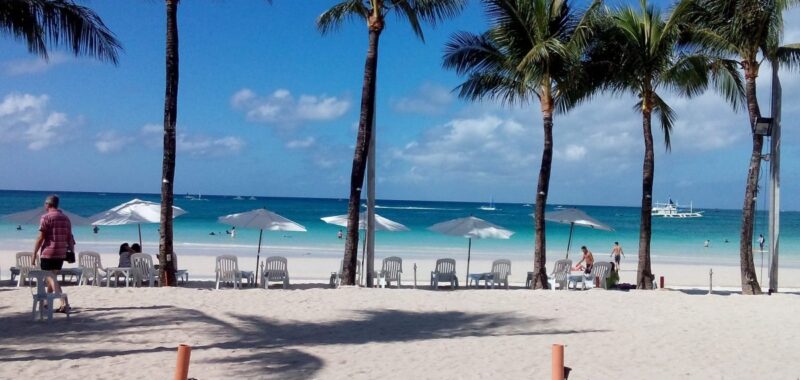The Philippines is gearing up to launch a digital nomad visa, joining other Asian countries that are opening their doors to remote workers.
For years, travelers have been drawn to the country for its white-sand beaches, crystal-clear waters, and famously friendly locals. But like many places, the country’s tourism industry took a big hit during the pandemic. While things are slowly picking up, the number of foreign visitors still hasn’t bounced back fully.
In 2024, the Philippines welcomed around 5.9 million international tourists, well below its target of 7.7 million. On the bright side, tourism revenue hit a record high of PHP 760.5 billion (about $13 billion), showing that those who did visit were spending more.
One big gap came from China. The country had hoped for over 2 million Chinese tourists last year but saw only around 300,000. This drop came after the Philippines suspended its e-visa system for Chinese travelers at the end of 2023, a policy that is still on hold.
Before Covid-19 hit, the Philippines saw 8.2 million international arrivals. The country this year aims to welcome 8.4 million foreign tourists.
Instead of just focusing on short-term tourists, the government now wants to attract remote workers who stay longer and spend more. Even a small share of the world’s digital nomads could bring a big economic boost.
The Global Digital Nomad study conducted in 2023 estimates that digital nomads contribute $787 billion to the global economy annually.
What Does the Digital Nomad Visa Offer?
The upcoming visa will allow eligible foreign remote workers to stay in the Philippines for up to a year, with the option to renew.
To qualify, applicants need to show they earn enough to support themselves, have a clean record, sufficient health insurance, and be from a country with reciprocal visa agreements.
The visa does not permit local employment, ensuring that digital nomads contribute to, rather than compete with, the domestic labor market.
Several government agencies, including the Department of Foreign Affairs, Bureau of Immigration, Department of Tourism, and Bureau of Internal Revenue, are working together to ensure the program is secure and rolls out smoothly. This work includes checking backgrounds, verifying income, and using digital tools to screen applicants.
Asia’s Digital Nomad Visa Race
The Philippines enters a crowded and increasingly competitive space.
From Thailand to Taiwan, Asian nations are vying for the same global demographic: mobile professionals who spend longer, travel deeper, and inject more into local economies than traditional tourists.
Here are some of the key programs:
- Japan’s visa for 6 months is non-extendable and demands a hefty income threshold of JPY10 million ($66,000), limiting accessibility.
- South Korea, with its two-year extendable visa and strong tech ecosystem, appeals to high-earning professionals but carries an income requirement of over $66,000.
- Taiwan offers shorter stays (up to six months) and a tiered income structure, but with more flexibility in proof of eligibility.
- Thailand’s Destination Thailand Visa (DTV) is uniquely flexible with a five-year validity and 180-day stays per entry, ideal for those who want to settle in without strict rules.
- Malaysia’s digital nomad visa extendable up to 2 years, strikes a balance between accessibility and infrastructure support, attracting both tech and non-tech remote workers. The minimum annual income should be $24,000 per year for tech professionals and $60,000 for non-tech talent.
- Indonesia is the latest to join the race. Digital nomads can live in the country for up to a year, with a possible one-year extension. To qualify, applicants need, among other things, a minimum annual income of $60,000 and a bank balance of at least $2,000 (maintained over three months).
What’s Makes the Philippines Stand Out?
English is widely spoken, the cost of living is low, and there’s easy access to both beaches and cities.
The visa should also be easier to get than in some other countries. But for the plan to truly succeed, the government will need to move quickly, build the right infrastructure, and create strong local communities, something which destinations like Thailand and Malaysia are already doing.
Of course, remote workers need more than just a visa. Infrastructure is key and that includes reliable internet and modern workspaces. That’s why the Department of Information and Communications Technology in Philippines is speeding up efforts to improve high-speed internet in popular tourist spots like Boracay, Palawan, Siargao, and La Union.
The government is also looking to invest in tech training and digital skills to encourage collaboration between locals and foreign professionals.
A ‘Progressive’ Initiative
There’s already momentum. Co-working and co-living spaces are popping up across the islands, and businesses are offering new services to meet the needs of this market.
The Philippines was ranked as the 7th fastest-growing remote work hub globally in 2023 by Nomad List, a platform tracking remote worker trends. This ranking was mentioned by the World Economic Forum last year.
Tourism Secretary Christina Frasco called the initiative “progressive.”
“Not only do digital nomads help mitigate seasonal fluctuations in tourism by visiting during off-peak times and providing a more steady economic flow, but these types of international visitors also bring diverse perspectives and cultures, enriching our host communities.” Frasco said, according to a Philippine News Agency report.

